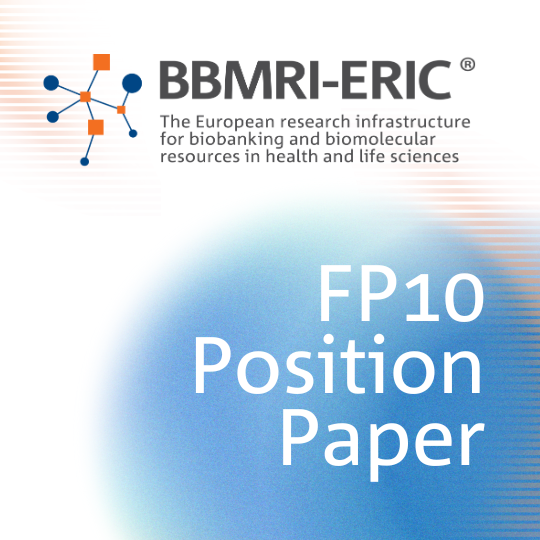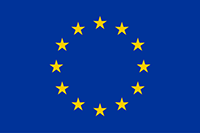I am looking for information as
Researcher

Industry

Patient

BBMRI-ERIC Launches FP10 Position Paper
This article is 1727 words and is an approximate 7-minute read.
BBMRI-ERIC, the European Research Infrastructure for Biobanking and Biomolecular Resources in Health and Life Science, has launched its position paper on the next Framework Programme (FP10).
One of the first research infrastructures to publish such a paper, it outlines six key messages for FP10 (explainer). The paper is timed with the current evaluation of Horizon Europe and mapping out the research, technology and innovation policies that should be shaped beyond 2027.
The six key messages for consideration are:
- Focus on a “One Health” approach in research
- Accelerate and advance research in the fields of cancer, rare diseases and paediatrics
- Shape the European Health Data Space (EHDS)
- Strengthen international research partnerships
- Consolidate research efforts by enabling access to different funding initiatives
- Avoid further diversification of the RI landscape
The position paper is informed by a community whose valuable knowledge and foresight is shaped by grassroots experience that centres on state-of-the-art biobanking innovation and research.
The release of this position paper brings into focus FP10 priorities that should incorporate the pivotal role biobanking plays in meeting the needs of healthier world. BBMRI-ERIC is looking forward to discussions on these topics.
The full paper is below and can be downloaded as a PDF document.
Position Paper
BBMRI-ERIC’s Vision for Framework Programme 10 (FP10)
May 2024
Introduction
As the Biobanking and Biomolecular Resources Research Infrastructure – European Research Infrastructure Consortium (BBMRI-ERIC)[1], we stand at the forefront of advancing health and life science research and innovation in Europe. With a member state network spanning 24 countries and WHO (IARC), BBMRI-ERIC plays a pivotal role in facilitating access to high-quality biological samples, data and biomolecular resources for interdisciplinary scientific research across Europe and beyond.
Just like Horizon Europe, the anticipated Tenth Framework Programme (FP10) will be one of the largest global research funding programmes. Its priorities, budget allocation and function will have a profound impact on Research Infrastructures. This paper outlines BBMRI-ERIC’s support for a strategic approach that prioritises the following key topics in the next Framework Programme:
- Focus on a “One Health” approach in research
- Accelerate and advance research in the fields of cancer, rare diseases and paediatrics
- Shape the European Health Data Space (EHDS)
- Strengthen international research partnerships
- Consolidate research efforts by enabling access to different funding initiatives
- Avoid further diversification of the RI landscape
1. Focus on a “One Health” approach in research
The alarming effects of global warming, alongside emerging pathogens and future pandemics, means “One Health” becomes a key priority area in the forthcoming FP10. The “One Health” approach holds significant importance for the European Research Area (ERA) and beyond due to its unique potential to address multifaceted challenges at the intersection of human, animal, and environmental health. The “One Health” concept has been driven by WHO as crucial for addressing these challenges.
Although well recognised on the global political level, this has not been reflected with financial support for research in Framework Programmes. ERA would benefit from “One Health” as cross-disciplinary scientific collaboration that is needed to tackle complex health research challenges. Research Infrastructures/ERICs have ample resources (such as biobank infrastructure) that could be used for tackling the overall challenges pertaining to “One Health”.
For example, biobanks are already providing critical samples for environmental longitudinal studies on human health and this should be further expanded towards animal and environmental health. Furthermore, promoting the “One Health” approach in research supports the development of innovative strategies and technologies that can enhance greening (also of Research Infrastructures), disease surveillance, prevention, and control.
2. Accelerate and advance research in the fields of cancer, rare diseases and paediatrics
It is imperative that cancer continues to be prioritised in FP10. Combatting cancer must remain a central focus for EU policy and funding initiatives by building on the EU Mission on Cancer, the Beating Cancer Plan etc. At the same time, however, topics that are closely related such as rare diseases and paediatrics need to be given sufficient focus in FP10.
BBMRI-ERIC plays a key role in addressing challenges of cancer. This has been achieved e.g. through the canSERV project, which bundles over 400 unique personalised oncology research services by building one common access platform. BBMRI-ERIC urges the European Commission to recognise the significant synergies that EU-funded calls for cancer research initiatives could offer when collaboratively addressing canSERV, EOSC4cancer, and UNCAN.eu in FP10.
While BBMRI-ERIC has also contributed to the European Joint Programme on Rare Diseases (EJP RD), in the future, an even stronger focus on rare diseases but also paediatrics will be needed as it is not only a matter of equity and compassion but also an investment in scientific progress, medical innovation, and the overall wellbeing of society. These are efforts that require long-term support.
3. Shape the European Health Data Space (EHDS)
Implementation of the European Health Data Space (EHDS) is paramount for future breakthroughs in health research. BBMRI-ERIC is a significant shaper of the EHDS, in particular through its participation in the EHDS2Pilot project, where it has implemented the only European-level data platform for secondary use of health data.
The EHDS Regulation designates ERICs, and therefore BBMRI-ERIC, as authorised participants of HealthData@EU, focusing on the reuse of health data for research and policymaking. However, the specifics of this designation are vaguely defined, prompting BBMRI-ERIC to explore how it can effectively integrate into this new ecosystem. BBMRI-ERIC is thus interested to explore how it can best support implementation of EHDS regarding the secondary use of health data. It should be noted that BBMRI-ERIC already connects and facilitates access to data and samples across its 25 member and observer countries.
4. Strengthen international research partnerships
Both the importance of a global “One Health” approach and focus on research priorities such as cancer, implies strengthening and expanding research project partnerships to third countries and across continents. It is necessary that FP10 increases funding for these collaborations. By providing specific funding for setting up and sustaining partnerships, knowledge exchange can be facilitated and thus foster cross-cultural understanding and promoting capacity building. This also aligns with other EU initiatives, such as EU Global Health Strategy.
5. Consolidate research efforts by enabling access to different funding initiatives
Effectively tackling societal challenges requires all relevant actors to come together. The Framework Programme operates through several Work Programmes, which have different funding streams and rules. In some cases, these are closed for specific actors such as Member States or large existing consortia. However, when tackling complex topics as EHDS, cancer or personalised medicine, it is crucial that Research Infrastructures are included and eligible to apply alongside other actors.
Research Infrastructures like BBMRI-ERIC have a perfect overview of the research and innovation landscape in various fields across Europe and bring valuable know-how to these large, pan-European, projects. Moreover, Research Infrastructures can be used as tools in all calls that handle various data. So far, Research Infrastructures have mostly been confined to their Work Programmes; this is a lost opportunity that can be solved by the European Commission including overarching concepts across domains and different dataspaces in FP10. To benefit synergies and avoid duplication, FP10 should allow for greater participation of Research Infrastructures across its Work Programmes, and crucially, in its large strategic calls around health and life sciences.
6. Avoid further diversification of the RI landscape
Research Infrastructures in general, and ERICs in particular, have been one of the most successful players in the ERA since its establishment. However, with a community of 28 and more in the pipeline, a long-term, strategic, pause in the establishment of new infrastructures is needed.
Instead, we call upon the EC to channel resources and efforts towards fortifying and expanding the capabilities of existing ERICs as strategic assets rather than funding further projects in preparation for future ERICs. New initiatives can instead build on existing infrastructure whenever possible and that meet mutual needs by working jointly with ERICs already in place.
By prioritising the enhancement of already established infrastructures, the community can leverage existing expertise, optimise resource allocation, maximise the impact of investments and avoid further legal and administrative complexity for Member States. In this respect calls like HORIZON-INFRA-2023-DEV-01 are of great value to existing Research Infrastructures, although their funding period is rather short.
Future, similar, calls should have a funding period of at least five years and incorporate the possibility for Research Infrastructures to join forces with smaller or newer initiatives for the long-term use of already existing resources. Outcomes of projects like INTEGRATE-LMedC should consistently build on existing Research Infrastructures, rather than investigate establishing new infrastructures. Through this strategic focus, we can ensure that our research ecosystem remains resilient, collaborative, and at the forefront of innovation, while simultaneously avoiding duplication of efforts and fostering a culture of continuous improvement within our scientific communities.
Finally, new concepts of Infrastructures, such as EDICs or Technological Infrastructures, have started to emerge during the current programme. It is necessary to be more prudent in establishing new concepts, which are closely connected to the idea and mission of ERICs, in order not to encourage a burst of new organisations due to funding availability. More effort should be given to explore how existing RIs, ERICs or not, can answer the needs of emerging communities.
Conclusion
BBMRI-ERIC urges the European Commission to prioritise “One Health”, research focusing on core topics such as cancer, rare diseases and paediatrics, and strengthening international cooperation for the forthcoming Framework Programme. Participation of Research Infrastructures to different EU funding initiatives in health and life sciences should be consolidated.
Further diversification of the Research Infrastructure landscape should be avoided; instead harness already existing synergies. Research Infrastructures are fundamental to the aspirations of the European scientific community, including EHDS, and will continue to set global standards in scientific advancement, innovation, and collaborative exploration. To fully realise long-lasting social, health, environmental and economic benefits require policymakers to make strategic investments in this future. Investing in research and innovation today means stronger competitiveness for the future.
[1] BBMRI-ERIC is the European research infrastructure for biobanking and biomolecular resources, established in 2013. Through our directory we enable access to close to 400 biobanks and over 3000 collections in the areas of e.g. cancer, rare diseases, paediatrics, and COVID-19 across Europe, making it the biggest biobanking directory in the world. We offer quality management services, online tools and software solutions, and support with ethical, legal, and societal issues. We bring together researchers, biobankers, industry, and patients with the goal of boosting biomedical research.






